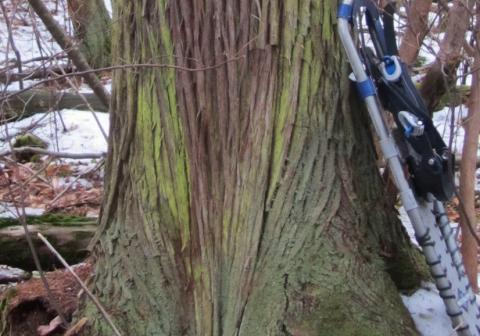A Tree Measuring Tale - Searching for Atlantic White Cedar

The tale begins years ago when my Tree Stewards class took a field trip to the unique and rare Atlantic White Cedar (Chamaecyparis thyoides) swamp on Hackett Hill Rd. in Manchester. I remember the lacy, arborvitae-like foliage and shaggy bark on the trunks trees growing on hummocks in the swamp. At that time this particular cedar swamp was under threat of being developed (now owned by the Nature Conservancy and open to the public - see the Manchester Cedar Swamp Preserve).
After completing the Tree Steward program (now Natural Resources Stewards program), I joined the Big Tree measuring team for Hillsborough County. Shortly thereafter, we received a nomination for an Atlantic White Cedar tree from a resident of Goffstown so once again I was off to find this beautiful tree. In the winter of 2011, it was cold enough for the Goffstown swamp to be frozen solid. One bitter yet sunny January day, I ventured out alone to search for the trees. I was happy to find the swamp right along the roadside and very happy to see that it was definitely an Atlantic White Cedar swamp & forest. I selected the largest one near the edge that I tried to measure by myself, beginning with the circumference of the trunk. The NH Big Tree Program uses the American Forests system for measuring. A score is derived from three tree measurements: circumference, height and crown spread. I had to take off my mittens to measure the trunk and my hands instantly froze! I quickly moved onto measuring the height of the cedar using a clinometer that is calibrated to sight the tree top at 100 feet from the trunk. By this time I was getting colder - just one more measurement - the crown. The trees were so close that the crowns were tiny and it was easy to measure the crown diameter in two directions and figure the average crown spread.
It was so cold that my camera wouldn't work. I pinched off a few tips from the young Atlantic White Cedar shoots to photograph at home. I stuck them in a little vase of water expecting them to turn brown and die. They didn’t - instead the foliage looked quite perky and healthy on my kitchen windowsill. So I left the twig, only to notice months later it looked as if the foliage was growing longer tips. Later it seemed that a tiny root was growing from the stem in the water! How exciting – by summer the vase was full of roots! I had a baby Atlantic White Cedar tree!
.jpg) It had been so cold that day, I planned to come back with help to get more accurate measurements and photos.However, time went by as the next two winters were mild and I was not interested in falling through ice into the cold swamp. But the bitter cold winter of 2013-14 was again perfect for measuring trees in a swamp. I knew that I needed help time, and contacted UNH Extension Forester for Hillsborough County, Jon Nute (now retired) . He was unaware of this cedar swamp just minutes away from his office, and was eager to see it. In March of 2014, Jon, team member Mike Callaghan and I were able to get the job done. Jon pointed out that this location at the top of a hill was a perched swamp – like a tea cup with a very consistent water level. He thought the stand look to be about 80 years old.
It had been so cold that day, I planned to come back with help to get more accurate measurements and photos.However, time went by as the next two winters were mild and I was not interested in falling through ice into the cold swamp. But the bitter cold winter of 2013-14 was again perfect for measuring trees in a swamp. I knew that I needed help time, and contacted UNH Extension Forester for Hillsborough County, Jon Nute (now retired) . He was unaware of this cedar swamp just minutes away from his office, and was eager to see it. In March of 2014, Jon, team member Mike Callaghan and I were able to get the job done. Jon pointed out that this location at the top of a hill was a perched swamp – like a tea cup with a very consistent water level. He thought the stand look to be about 80 years old.
More on Atlantic White Cedars
Atlantic White Cedar swamps are rare in NH according to the Natural Heritage Bureau’s Natural Communities fact sheet. NH is on the northern edge of their natural range and the trees survive in isolated pockets along the coast and some inland locations south of Concord. Nationally, the tree is true to its name and is grows along the Atlantic coastal plain from Maine to the Gulf, but not far inland. It is classified in the Cypress family (Cupressance) along with CA redwoods, our native arborvitae or Northern White Cedar (Thuja occidentalis) that grows in colder climates north of Concord, and our Eastern Red Cedar (Juniperus Virginia), that pops up in abandoned pastures statewide. The foliage of these three NH conifer trees is similar, but the seed pods are not: Atlantic White Cedar produces a crumpled roundish seed cone, the Northern White Cedar has an elliptical cone with scales, and Eastern Red Cedar has blue juniper berries. Atlantic White Cedar is native to our continent, unknown in Europe, and one of the first exports from the Colonies. In the 1600s ships from Jamestown returned to Europe with lumber from the shores of Virginia. It was valued for its lightweight, straight grain - good for boat building. Its excellent rot resistant qualities make it perfect for shake roofs, clapboards, fence posts and later RR ties and outdoor furniture.
Coincidentally, I came across a fascinating book The Brother Gardeners, by Andrea Wulf. She describes the amazing story of an early American farmer and naturalist John Bartram who had a little farm on the banks Schuylkill River on the outskirts of Philadelphia where grew exotic plants. He stumbled into the horticulture business of shipping new American plants back to the obsessed gardeners of Britain and Europe. They were eager for plants from America that they hoped would be more cold hardy that those imported from Central and South America. In 1736 he apparently included Atlantic White Cedar in his ‘boxes’ of plants shipped to England where it was a hit with landscapers and botanists (plant collecting seemed to be an obsession of the wealthy). It was popular for its narrow conical shape and became one of his most expensive plants. So he searched the coast for more and discovered them in abundance in New Jersey in the Hackensack meadowlands. He and his English partner kept the secret that it was easy to propagate from cuttings.( It is interesting that it was so popular for landscaping back then as it is not a plant used in the nursery business today, probably because of its precise water needs – not too much and not too little. Another problem in the landscape is that deer are fond of it and also arborvitae, and eat the bottom branches during the winter in NH.)
Lots of others discovered the valuable NJ coastal source of lumber and Atlantic White Cedar was literally slashed down. Interest in the practicability of restoration of the lost New Jersey Atlantic White Cedar forests led to a study and an excellent report that nicely summarizes the history of the white cedar lumber business in NJ from the 1600s through the 20th century: Atlantic white-cedar Ecology and Best Management Practices Manual by Kristin A. Mylecraine and George L. Zimmermann Under the editorial guidance of the NJ Atlantic White-Cedar Initiative Steering Committee 2000.
The researchers concluded that at the time of European settlement, there may have been as many as 500,000 acres of Atlantic White Cedar in NJ. By 1995 only 115,000 acres were estimated to remain and it is gone from the Meadowlands. They even mined the logs buried in the swamps. Heavy cedar cutting also occurred in other regions. In the 19th century, in North Carolina cedar harvesting was expedited by the development of steam-powered trains and dredging equipment, to drain previously inaccessible cedar swamps. Some speculate that 50% of all the existing White-Cedar acreage in the state was cut between 1870 and 1890.
With the hope of better protecting AWC wetlands, the NH Heritage Bureau in 1993 commissioned a study that found 20 larger sites remaining in NH, many linked to glacial features like kettle holes and moraine hollows. Changes in water levels from dams to the draining of wetlands has been a factor in loss of Atlantic White Cedar forests in NH. In 1994 – less than 550-600 acres Atlantic white cedar remained, many of the locations are along the coast. Another public area is the Cooper Cedar Woods in New Durham owned by the Forest Society.
To see a list of NH's biggest Atlantic White Cedars, check out NH's State and County Big Tree Champions. If you know of a large Atlantic White Cedar that may not yet be on the list, check out How to Nominate a Big Tree.
About the Author
Anne Krantz admits, “I literally stumbled into the fascinating the Natural Resources Stewards Program and followed that with the comprehensive Master Gardener training.” Participating in a special training in 2009, Anne became part of the first team of volunteers to answer homeowner questions at the Education Center, an activity she continues to love.
“Because of these excellent education opportunities I now serve on my conservation commission, the NH Pesticide Board and the Rivers Management Advisory Council," she says. "I have also enjoyed UNH Extension's Big Tree program; I just found a flowering native chestnut tree this morning!”

